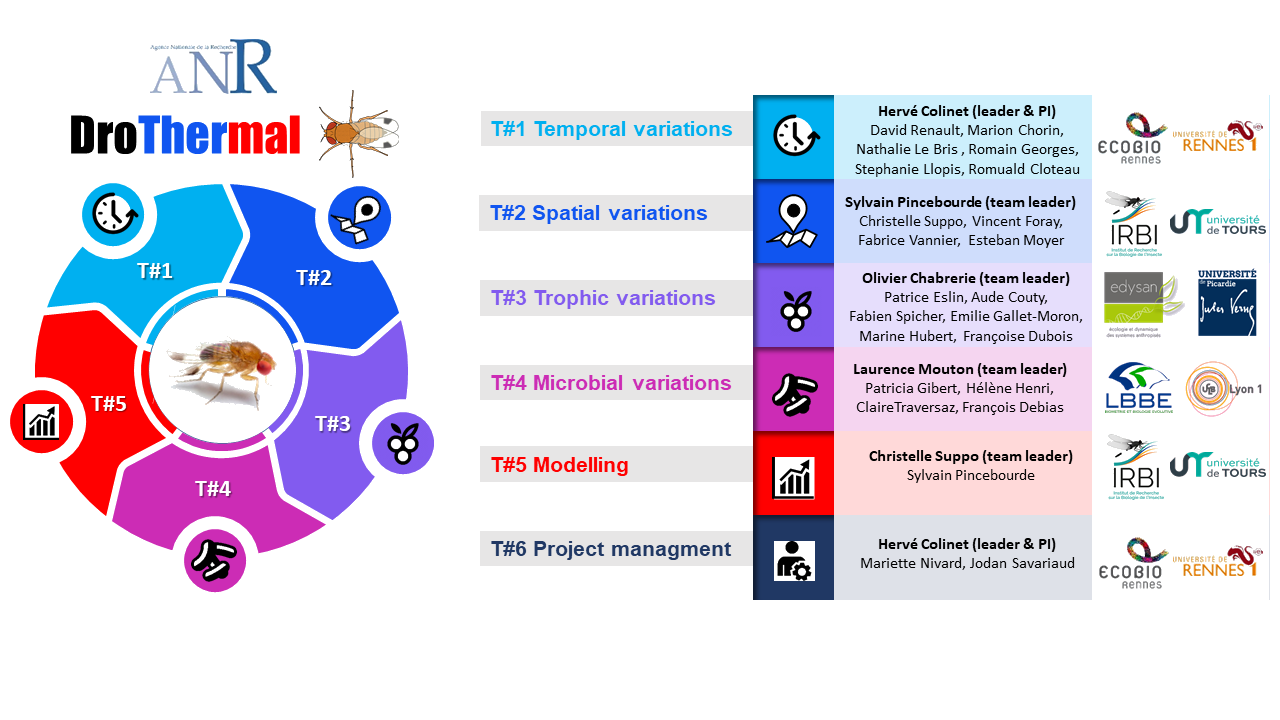Drothermal
 |
What makes Drosophila suzukii such a successful invader?
An integrative analysis of its thermal ecology [DroThermal]
2021-2025
Funded by ANR
Project summary
The recent invasion by the Spotted Wing
Drosophila (SWD) is a major concern for the fruit sector worldwide. Temperature
and thermal biology of this species are recognized as the main factors
dictating the distribution, populations’ dynamics and seasonal phenology of
SWD. However, major knowledge gaps remain regarding its thermal and trophic
ecology, thus compromising the assessment and prediction of field population
dynamics from year to year. In particular, there is a critical lack of
knowledge about the thermotolerance and winter survival strategies of this invasive
species, which are essential for anticipating spring population levels and
dynamics. Small insects such as fruit flies certainly respond to environmental
variations on much finer temporal and spatial scales than those generally
considered so far in classical experimental studies and predictive models. The
transfer of the macroclimate projections into the microclimates actually
encountered by SWDs in nature requires the acquisition of novel ecologically
relevant data with a level of resolution corresponding to the insect's scale.
DroThermal is based on the idea that most of the findings from laboratory
experiments are difficult to extrapolate to field situations. Current knowledge
on the thermal and trophic ecology of SWD is mainly based on laboratory data
that lack the appropriate resolution and ecological relevance and thus hamper
the accurate assessment of the persistence of SWD populations in the wild, as
well as the associated modelling efforts. Many critical variables are at play
in nature but absent from classical experimental conditions: i) unlike the
laboratory where conditions are constant and optimal, there is a high spatial
and temporal variability of abiotic factors (e.g. temperature) in nature
(subject of tasks 1 & 2). ii) there is a high diversity of host plants that
varies with the seasons and thus a range of available trophic resources
(including unknown winter hosts) that shape phenotypes such as thermotolerance
(subject of task 3). iii) Symbionts and microbes associated with the host (e.g.
Wolbachia) are much more diverse in nature than in the laboratory, and can
affect host characteristics, including thermotolerance (subject of task 4).
Consideration of these effects in a single integrative project will generate
new knowledge on the thermal and seasonal ecology of SWD, allowing better
modelling of population dynamics and seasonal phenology (subject of task 5). By
considering different levels of variation across appropriate spatio-temporal
scales, we plan to elucidate the thermal (and seasonal) responses and
adaptations of SWD, and thus better predict population persistence and dynamics
in the field. DroThermal also has the applied goal of generating data needed to
develop innovative predictive models of population dynamics, which are useful for
sustainable management programs against SWD. Our high-resolution integrative
approach will provide a better understanding of the invasive success of this
species in temperate regions and will provide new knowledge essential for the
management of SWD, such as improving the timing and forecasting of control
measures. More broadly, the project will provide an innovative new framework to
understand the success of biological invasions that present significant eco-socio-economic
issues.


Project Partners
 |


Coordinator contact
Hervé Colinet (CR-CNRS HDR)
UMR ECOBIO CNRS 6553, Bat. 14A
Université de Rennes 1
263 AVE du Général Leclerc
CS 74205
35042 Rennes Cedex
FRANCE
tél : +33 (0)2 23 23 64 38
email :
herve.colinet@univ-rennes1.fr

The results of DROTHERMAL project are listed :
here
 |

 link to the participative project "DroFramb"
link to the participative project "DroFramb"
here
Drothermal website produced by Herve COLINET and hosted by CNRS










